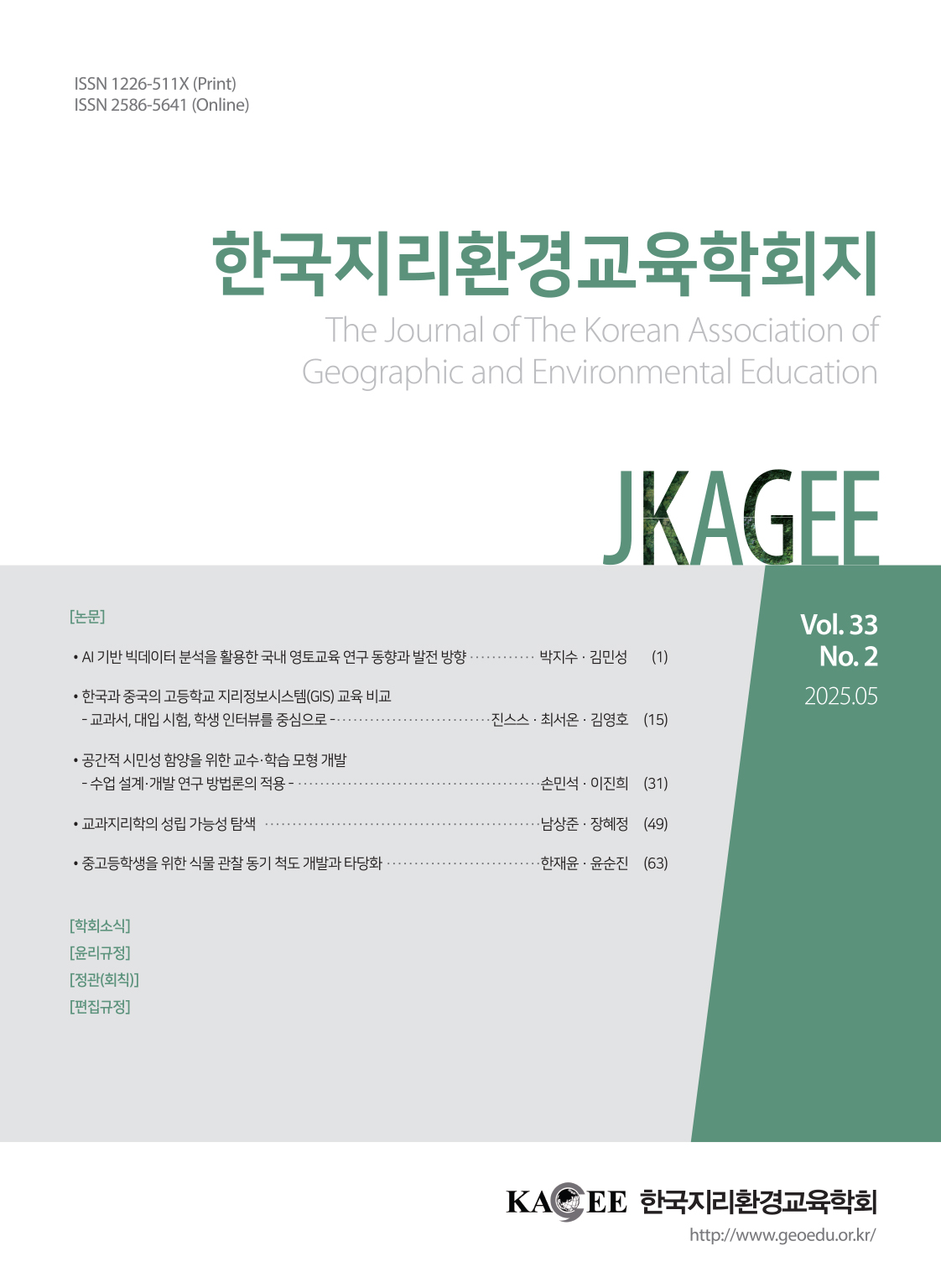Research Article
Abstract
References
Information
The purpose of this study is to investigate the pedagogical effects of student-centered convergence project class in which participants played a leading role in tackling diverse topics. The project used geospatial services as a main tool for analysis and visualization, and the geographic perspective integrated other subjects’ concepts and perspectives. In order to analyze the educational effects of the project, this article administered an attitude test and a satisfaction test. In the case of the attitude test, scores of pre- and post-tests were compared. As a result, statistically significant differences were found in the dimensions of total score, career selection, communication, and interest. In the satisfaction test conducted after the activity, the participants responded positively in satisfaction, interest, participation, and follow-up intention, indicating that they were generally satisfied with the activities. This study adds to the literature in that it empirically verified the pedagogical benefits of student-centered convergence research using geospatial services.
이 연구의 목적은 학생 주도의 융복합 연구 프로젝트를 실시하고 그 교육적 효과를 살펴보는 것이다. 융복합 프로젝트는 지리공간서비스를 주된 분석과 시각화의 도구로 활용하였고, 지리적 관점을 기본으로 다른 교과의 개념과 시각을 통합하는 방식으로 진행되었다. 프로젝트 학습의 효과 검증을 위해 수업 태도와 만족도 검사를 실시하였다. 태도 검사는 활동 전후의 차이를 비교하였는데 전체 영역, 진로선택 영역, 소통 영역, 흥미 영역에서 통계적으로 유의미한 차이가 나타났다. 활동 후 이루어진 만족도 검사에서는 수업만족도, 흥미도, 참여도, 후속 참여 의향에서 높은 점수를 보여 연구참여자들이 전반적으로 활동에 만족하는 모습을 확인할 수 있었다. 본 연구는 지리공간서비스를 활용한 학생 연구 중심 융복합 프로젝트 학습의 교육적 효과를 실증적으로 검증했다는 점에서 의미가 있다.
- 교육과학기술부, 2009, 사회과 교육과정, 교육과학기술부 고시 제2009-41호 [별책 7].
- 교육부, 2014, 2009 개정 교육과정에 따른 고등학교 사회과 핵심 성취기준의 이해.
- 교육부, 2015, 사회과 교육과정, 교육부 고시 제2015-74호 [별책 7].
- 김민성, 2010, “교육 현장의 GIS 관련 상황과 교육적 사용을 위해 고려해야 할 요소”, 한국지리환경교육학회지, 18(2), 173-184. 10.17279/jkagee.2010.18.2.173
- 김민성, 2011, “지리교육 연구에서의 양적 방법론: 효과 크기의 개념과 활용”, 한국지리환경교육학회지, 19(2), 205-220. 10.17279/jkagee.2011.19.2.205
- 김민성, 2019, “프로젝트기반학습에서 대학원생들의 멘토링 경험에 대한 내러티브 탐구”, 학습자중심교과교육연구, 19(5), 239-262.
- 김민성, 2020a, “온라인 시각화 도구를 활용한 대학생들의 일상생활공간 탐색”, 한국지리학회지, 9(1), 1-15. 10.25202/JAKG.9.1.1
- 김민성, 2020b, “지리에 대한 인식 조사: 지리 전공과 비전공 대학생 비교를 중심으로”, 한국지리환경교육학회지, 28(1), 33-47.
- 김민성・유수진, 2014, “지리공간기술을 이용하는 목표기반시나리오 학습모듈 개발”, 사회과교육, 53(1), 79-93.
- 김민성・이상일・이소영, 2016, “지리공간서비스의 교육적 함의와 교수학습 모델 개발”,
The SNU Journal of Education Research , 25(1), 1-26. - 김민성・이창호, 2015, “지리공간기술 기반 봉사학습 프로젝트: 지오투어리즘 관점에서의 지역사회 참여”, 한국지도학회지, 15(3), 63-77. 10.16879/jkca.2015.15.3.063
- 박현주・백윤수・심재호・손연아・한혜숙・변수용・서영진・김은진, 2014, STEAM 프로그램 효과성 제고 및 현장 활용도 향상 기본연구, 한국과학창의재단 연구보고서BD15030009.
- 송신철・김정민・심규철, 2021, “고등학생 STEAM 기반 학생연구과제에 나타난 STEAM 요소 및 과학 분야의 융합 유형 분석”, 학습자중심교과교육연구, 21(2), 509-534.
- 안선경・이희수・모영화・이호욱, 2020, “『택리지』 중심의 공동탐구토론 기반 STEAM 프로그램 개발 및 적용 사례 연구”, 교원교육, 36(2), 195-213.
- 이종원, 2011, “공간정보기술을 활용한 교수・학습모듈의 개발과 평가”, 한국지리환경교육학회지, 19(3), 381-397. 10.17279/jkagee.2011.19.3.381
- 이종원, 2015, “학습자의 참여와 과제의 실제성을 강조하는 지리 교수・학습자료의 개발과 활용”, 한국지리환경교육학회지, 23(1), 65-82. 10.17279/jkagee.2015.23.1.65
- 전보애, 2014, “공간정보기술을 활용한 영토교육 모형의 개발과 적용: 창의적 체험활동을 중심으로”, 한국사진지리학회지, 24(4), 1-13.
- 전보애, 2018a, “'드론을 활용한 지도 만들기' 자유학기제 수업 모듈 개발과 적용”, 한국사진지리학회지, 28(4), 49-66.
- 전보애, 2018b, “지리교육에서 지오클라우드의 이해와 적용”, 현대 지리교육학의 이해, 한국지리환경교육학회, 푸른길, 199-217.
- 전상희・안승만・최영진・성효현, 2011, “GIS를 이용한 풍력발전단지 최적입지 선정방법에 관한 연구”, 신재생에너지, 7(3), 83-91. 10.7849/ksnre.2011.7.3.083
- 최재붕, 2020, 포노 사피엔스 코드 CHANGE 9, 쌤앤파커스.
- 한혜정, 2019, “고교학점제 도입을 위한 고등학교 교육과정 구조 관련 쟁점 및 향후 연구의 방향 탐색”, 교육과정연구, 37(2), 53-81. 10.15708/KSCS.37.2.3
- 홍후조, 2018, “고교 학점제 도입의 문제와 과제”, 학습자중심교과교육연구, 18(1), 699-724.
- Aldabbus, S., 2018, Project-based learning: Implementation & challenges,
International Journal of Education, Learning and Development , 6(3), 71-79. - Baerwald, T. J., 2010, Prospects for geography as an interdisciplinary discipline,
Annals of the Association of American Geographers , 100(3), 493-501. 10.1080/00045608.2010.485443 - Baker, T. R., Battersby, S., Bednarz, S. W., Bodzin, A. M., Kolvoord, B., Moore, S., Sinton, D., and Uttal, D., 2015, A research agenda for geospatial technologies and learning,
Journal of Geography , 114(3), 118-130. 10.1080/00221341.2014.950684 - Bednarz, S. W., 2019, Geography's secret powers to save the world,
The Canadian Geographer , 63(4), 520-529. 10.1111/cag.12539 - Bell, S., 2010, Project-based learning for the 21st century: Skills for the future,
The Clearning House , 83(2), 39-43. 10.1080/00098650903505415 - De Miguel González, R. and De Lázaro Torres, M. L., 2020, WebGIS implementation and effectiveness in secondary education using the Digital Atlas for schools,
Journal of Geography , 119(2), 74-85. 10.1080/00221341.2020.1726991 - DiBiase, D., Corbin, T., Fox, T., Francica, J., Green, K., Jackson, J., Jeffress, G., Jones, B., Jones, B., Mennis, J., Schuckman, K., Smith, C., and van Sickle, J., 2010, The new geospatial technology competency model: Bringing workforce needs into focus,
URISA Journal , 22(2), 55-72. - Downs, R. M., 2016, Bringing geography back to life: The role of the geospatial revolution in the US school system,
Geography , 101(2), 77-84. 10.1080/00167487.2016.12093988 - Gewin, V., 2004, Mapping opportunities,
Nature , 427, 376-377. 10.1038/nj6972-376a 14737173 - Hart, J., 2019, Interdisciplinary project-based learning as a means of developing employability skills in undergraduate science degree programs,
Journal of Teaching and Learning for Graduate Employability , 10(2), 50-66. 10.21153/jtlge2019vol10no2art827 - Huck, S. W., 2008,
Reading Statistics and Research , 5th ed., Pearson Education, Boston, MA. - Jant, E. A., Uttal, D. H., Kolvoord, R., James, K., and Msall, C., 2020, Defining and measuring the influences of GIS-based instruction on students' STEM-relevant reasoning,
Journal of Geography , 119(1), 22-31. 10.1080/00221341.2019.1676819 - Joyce, K. E., Meiklejohn, N., and Mead, P. C., 2020, Using minidrones to teach geospatial technology fundamentals,
Drones , 4(3), 57. 10.3390/drones4030057 - Kerski, J. J., 2015, Opportunities and challenges in using geospatial technologies for education, in Muñiz Solari, O., Demirci, A., and van der Schee, J.(eds.),
Geospatial Technologies and Geography Education in a Changing World: Geospatial Practices and Lessons Learned , Springer, Tokyo, 183-194. - Kim, M., 2018, Project-based community participatory action research using geographic information technologies,
Journal of Geography in Higher Education , 42(1), 61-79. 10.1080/03098265.2017.1335294 - Kim, M., Kim, K., and Lee, S., 2013, Pedagogical potential of a web-based GIS application for migration data: A preliminary investigation in the context of South Korea,
Journal of Geography , 112(3), 97-107. 10.1080/00221341.2012.709261 - Kim, M. and Shin, J., 2016, The pedagogical benefits of SimCity in urban geography education,
Journal of Geography , 115(2), 39-50. 10.1080/00221341.2015.1061585 - Kolvoord, B., Keranen, K., and Rittenhouse, S., 2019, The geospatial semester: Concurrent enrollment in geospatial technologies,
Journal of Geography , 118(1), 3-10. 10.1080/00221341.2018.1483961 - Krippendorff, K., 2004,
Content Analysis: An Introduction to Its Methodology , 2nd ed., Sage, Thousand Oaks, CA. - Kuhn, W., 2012, Core concepts of spatial information for transdisciplinary research,
International Journal of Geographical Information Science , 26(12), 2267-2276. 10.1080/13658816.2012.722637 - Musa, F., Mufti, N., Latiff, R. A., and Amin, M. M., 2012, Project-based learning (PjBL): Inculcating soft skills in 21st century workplace,
Procedia-Social and Behavioral Sciences , 59, 565-573. 10.1016/j.sbspro.2012.09.315 - National Research Council, 2006,
Learning to Think Spatially: GIS as a Support System in the K-12 Curriculum , The National Academies Press, Washington, DC. - Owens, A. D. and Hite, R. L., in press, Enhancing student communication competencies in STEM using virtual global collaboration project based learning,
Research in Science & Technological Education . - Ricker, B. A., Rickles, P. R., Fagg, G. A., and Haklay, M. E., 2020, Tool, toolmaker, and scientist: Case study experiences using GIS in interdisciplinary research,
Cartography and Geographic Information Science , 47(4), 350-366. 10.1080/15230406.2020.1748113 - Solís, P., Huynh, N. T., Carpenter, D., De Newbill, M. A., and Ojeda, L., 2017, Using an authentic project based learning framework to support integrated geography education linked to standards and geospatial competencies,
Research in Geographic Education , 19(2), 36-65. - Soparat, S., Arnold, S. R., and Klaysom, S., 2015, The development of Thai learners' key competencies by project-based learning using ICT,
International Journal of Research in Education and Science (IJRES) , 1(1), 11-22. 10.21890/ijres.01778 - Uttal, D. H., Miller, D. I., and Newcombe, N. S., 2013, Exploring and enhancing spatial thinking: Links to achievement in science, technology, engineering, and mathematics?,
Current Directions in Psychological Science , 22(5), 367-373. 10.1177/0963721413484756
- Publisher :The Korean Association Of Geographic And Environmental Education
- Publisher(Ko) :한국지리환경교육학회
- Journal Title :The Journal of The Korean Association of Geographic and Environmental Education
- Journal Title(Ko) :한국지리환경교육학회지
- Volume : 29
- No :2
- Pages :53-69
- DOI :https://doi.org/10.17279/jkagee.2021.29.2.53



 The Journal of The Korean Association of Geographic and Environmental Education
The Journal of The Korean Association of Geographic and Environmental Education







